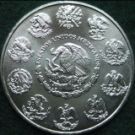At the first dealer display I stopped at, a customer was completing the purchase of approximately 200 Walking Liberty half dollars. The dealer's price was $7.50 per coin or 15 times face. The customer may have gotten a volume discount but in smaller amounts that is not a bad price. These were circulated coins so each would have about .3575 troy ounces of silver (versus .3617 if uncirculated). Other dealers have told me that some customers of 90% silver coins are only interested in silver half dollars with the Walking Libertys much preferred. To me that is totally understandable. Not only is this one of the most beautiful U.S. coins ever minted, it was first struck prior to the U.S. entry in World War I, was used in daily commerce throughout the Great Depression and all of World War II before yielding to the Franklin half dollar in 1947.

 One of my few purchases at the show was a one ounce silver Mexican Libertad. The dealer had a few on display but this one stood out from the others because it was struck with such great detail. Almost like a high-relief coin compared with the other Libertads he had available. One side of the coin features a winged Victoria of Mexican Independence Victory Column in front of a landscape with two volcanoes which I can't pronounce (Popocatepetl and Ixlaccihuatl). The other side features the coat of arms of Mexico surrounded by historical Mexican coats of arms.
One of my few purchases at the show was a one ounce silver Mexican Libertad. The dealer had a few on display but this one stood out from the others because it was struck with such great detail. Almost like a high-relief coin compared with the other Libertads he had available. One side of the coin features a winged Victoria of Mexican Independence Victory Column in front of a landscape with two volcanoes which I can't pronounce (Popocatepetl and Ixlaccihuatl). The other side features the coat of arms of Mexico surrounded by historical Mexican coats of arms. If you are not familiar with these coins, Mexican Libertads are government-issued gold and silver coins. The .999 silver Libertad was introduced in 1982 in one ounce versions only. In 1991, fractional Libertads of 1/20 ounce, 1/10 ounce, 1/4 ounce and 1/2 ounce were introduced and in 1996 2 ounce and 5 ounce Libertads were added to the series. Also, beginning in 1983, silver Proof Libertads became available in the one ounce versions with Proof fractionals added in 1993. You can find out more about these silver bullion coins at Wikipedia.
These are really great coins to own and if you find some at a price you are willing to pay, don't hesitate to invest in them. They are universally recognized and accepted. I have not heard of counterfeit Libertads being discovered but that doesn't mean they aren't out there. It pays to deal only with trusted sources for any precious metals purchases.
Thanks for reading. JA






